Stock car racing, when it started, was just a group of stock car owners racing their cars with the engines tweaked to get maximum power out of them. The safety of the drivers or the onlookers was least on the minds of these car owners. In 1948, Bill France Sr. formed the National Association for Stock Car Racing and started regulating stock car racing in the United States of America. As the speed of the cars increased causing more and more accidents, drivers slowly recognised the need for safety for themselves. They started using ropes and cables to secure themselves to the seats to prevent being bounced around in bumps and accidents.
Drivers started fortifying their cars with steel frames for protection but that measure only increased the weight of their cars. NASCAR also made certain safety features like seat belts compulsory in acknowledgement of the danger to the drivers and spectators. It was only after seven-time champion Dale Earnhardt during the 2001 Daytona 500 that NASCAR decided that the safety of drivers and others was of paramount importance. After researching for seven years NASCAR announced the Car of Tomorrow, a car design that would help protect drivers.
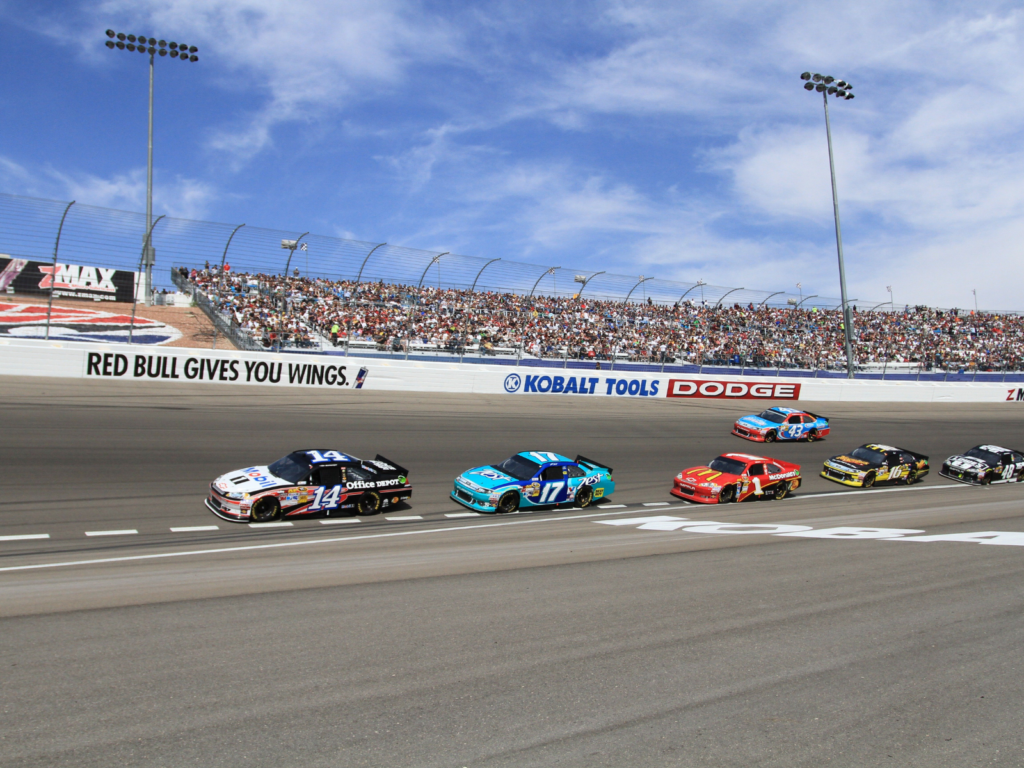
Car of Tomorrow (CoT)
The Car of Tomorrow was a result of a five-year project to improve the safety of drivers. With an improved design, the fifth-generation car was broader and boxier than the earlier cars. It was roundly criticised for its poor handling and generic looks but had many safety improvements that drivers appreciated. The sturdy car was easier and less costly to maintain and made for closer competition. The car was introduced in the 2007 racing season and by the 2008 season, all the cars were required to conform to the specifications.
The Car of Tomorrow was used till the 2008 racing season. In the 2009 season, a sixth-generation car was introduced by NASCAR. In the latest car, the body design was improved and additional safety measures were introduced. Many teams just changed the old car bodies with new ones with the necessary safety requirements incorporated.
What safety features do NASCAR cars have today?
NASCAR introduced the sixth-generation (Gen-6) car in 2013. The CoT or the fifth-generation car was retired after four years of use. The sixth-generation car was initially introduced in the 2011 Xfinity series and retained some of the safety features of the CoT. NASCAR had plans to introduce a car with better safety features in 2021. But the COVID-19 pandemic thwarted their plans. The seventh-generation car, or the Next-Gen car, will debut in 2022.
The present-day NASCAR car is a strong skeleton of metal tubing and carbon fibre. This skeleton is covered with metal sheets that are designed to absorb the shocks of bumps, accidents and crashes. Many safety features are incorporated that protect drivers to a great degree. NASCAR is acutely aware of the many drivers that have died in car crashes and other accidents of seemingly minor injuries.
What is the function of the roll cage in a NASCAR car?
The roll cage is the frontline defence of the NASCAR driver in case of a crash. The purpose of the roll cage is to absorb as much shock from the impact as possible. That gives the other safety devices like safety belts and the clips to operate. This helps to slow down the movement of the driver’s body to the minimum thereby protecting him from bodily harm. The roll cage is so designed that the car roof will not deform greatly when the car rolls or ends up on its roof. This prevents the car from getting smashed up and protects the driver.
The body frame of a NASCAR car has three sections just like a streetcar. They are the front clip, the middle section (that includes the roll cage) and the rear clip.
- The front clip is built with tubes made of a thinner section so that they will collapse on impact with a wall or another car. This helps absorb most of the energy and slow down the driver’s body movements. In a NASCAR car, the front clips are also designed to push the engine down and out rather than into the driver’s cabin. This feature has saved many drivers’ lives in crashes.
- The middle section is made of strong metal tubes that will maintain the cabin’s integrity in the event of a crash. This section will help the car roll over and more often than not help the car end up on the tyres rather than the roof. That is because the roll cage is in this section of the car. In the case of severe accidents, the roll cage is the only part of the car that remains in one piece.
- The rear clip, like the front clip, is less strong than the middle section. In case a car crashes into the back of a NASCAR car, the rear clip will collapse absorbing most of the shock of the collision.
The roll cage is an important section of the car frame because that is the section in which the driver seats and has to be protected. A lot of attention goes towards the construction of the roll cage and the car frame of a NASCAR car. NASCAR has strict guidelines regulating the construction of a car roll cage.
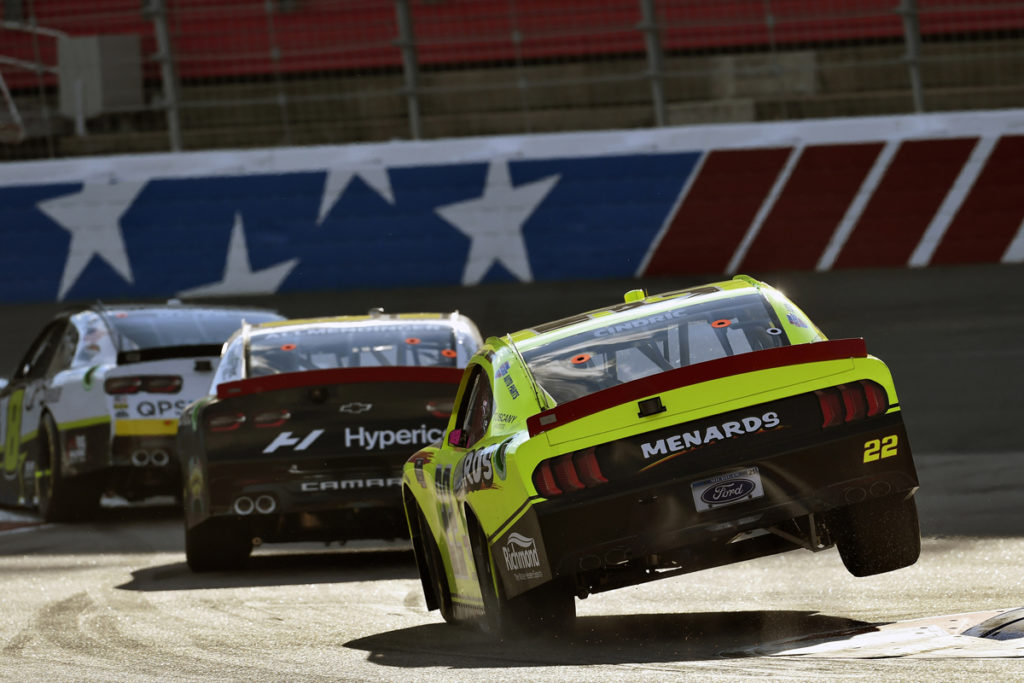
How has the seat of a NASCAR car improved?
The racing car seat is the part of the car in which a race driver spends several hours concentrating during the length of the race. The inside of the driver’s cabin in a NASCAR car is very hot from the heat generated by the engine. Temperatures inside the car can reach 130 degrees Fahrenheit (54 degrees Centigrade). No matter how good the seat is, the driver spends a long and uncomfortable time in that seat. The driver’s seat of a NASCAR car has several important functions to keep the driver safe if the car crashes.
- The primary purpose of the car seat is to keep the driver firmly in place in the event of a crash. The driver has to be inside the car’s roll cage and secured to the seat.
- The securing system of the seat must prevent any part of the driver’s body from coming in contact with a hard surface or an object.
- The seat should bend enough, depending on the severity of the crash, so that it absorbs some of the energy. This will save the driver from very sudden movements that may cause hurt to him.
Seats coming out of their mounting and being flung out of the cars have caused many deaths. Drivers have died while fastened to their seats in some crashes. NASCAR has now made it mandatory that car seats shall be bolted or welded at many points directly to the strong tubes of the roll cage. The drivers will remain in the roll cage when a car is involved in a severe crash, reducing their chances of getting hurt. It also prevents the driver from coming in contact with other areas of the cabin.
The seats in NASCAR cars virtually wrap around the driver’s body. The shape of the seat is made as comfortable as possible and is designed and constructed to suit the specific drivers. The support to the rib cage of the driver by the seat spreads the load of the impact over the whole rib cage. The load would otherwise have concentrated on a few narrow points where the driver is fastened by seat belts. Some car seats also wrap around the driver’s shoulders. As the shoulder bones are stronger, the seat supports the driver’s body even better when a car crashes.
Seats of NASCAR cars are made from carbon fibre which weighs less than traditional seats and is stronger than traditional seats. Carbon fibre also absorbs more energy of an impact than do aluminium seats as they are more flexible.
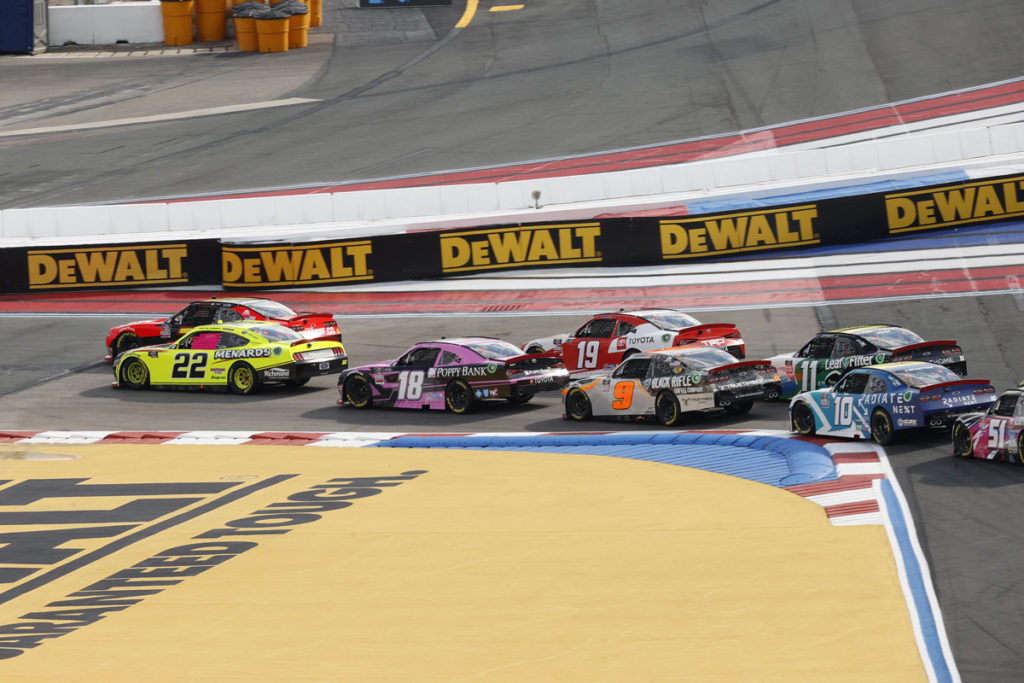
What are driver restraints in a NASCAR car?
Driver restraints are the measures implemented to keep the driver securely in his seat in the event of an impact. No matter how severe the impact is, the driver remains in his seat and within the roll cage. NASCAR has introduced many new measures to protect drivers in adverse conditions. Among them are fire retardant racing suits, safety belts and harnesses, window nets, roof plates and more. Drivers of NASCAR cars are also required to wear seven-point safety harnesses which keeps their whole body secured while keeping their arms and legs free.
Fire retardant racing suits and helmets
All drivers competing in a NASCAR race are required to wear a racing suit and underwear made from fire retardant material. It is also mandatory to wear helmets certified by NASCAR and other US safety agencies. The floor of the car gets very hot with the heat generated by the engine and brake shoes. Drivers also wear fire-retardant shoes. Besides, their shoes have a heat shield at the bottom to protect their feet from the extreme heat that can be generated during a long drive.
The helmet protects the driver from head and neck injuries. The helmet is also hooked up to the radio communication system and helps the driver communicate with the crew chief and the “spotter.” Whenever the driver wants, helmets can be fitted with visors that reduce sun glare. This helps the driver have a better vision of the track while racing at high speed. The helmets are also connected to the “HANS device” which reduces the risk of neck injuries and concussions during severe impacts.
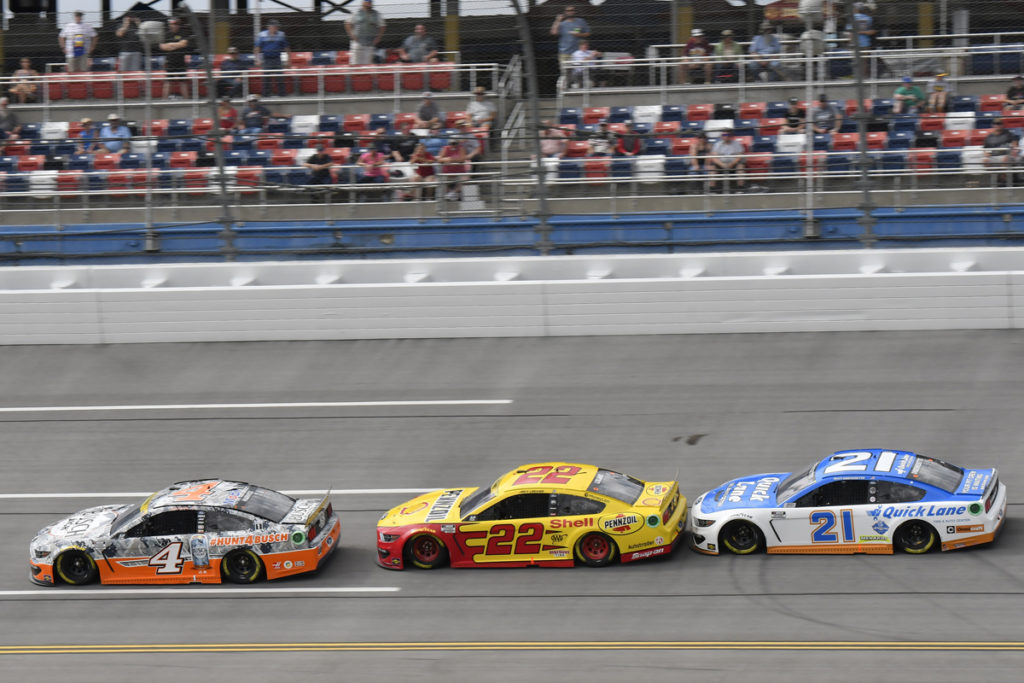
Seat belts and safety harnesses
Seat belts are the same that are used in street cars but are much stronger. After the death of several racers, NASCAR realised that they needed better safety for the car drivers. They mandated a five-point harness in 1993 and advanced to a six-point harness in 2007. These harnesses were good in keeping the driver in his seat. But a better harness, a seven-point harness evolved. From the 2015 season, NASCAR made it necessary for all racing drivers to use a seven-point harness.
Seven-point harness
Seven point harnesses are used in all NASCAR races since 2015. These harnesses have two shoulder belts, two lap belts and three submarine belts. All these belts are locked into a single cam buckle. This ensures that the driver’s body is firmly buckled to the seat with the belts. The seat and the car body absorb most of the shock of any impact. At the same time, the driver’s arms and legs are free. The arms and legs can give inputs to the car rather than prevent unwanted motion of the body in adverse conditions.
The two shoulder belts secure the upper body of the driver in place leaving his arms free to operate the car. The two-lap belts make sure that the thighs of the driver are secured leaving the drivers lower legs free. Of the three submarine belts, two belts secure the pelvis of the driver to the seat. This assures that the driver’s body does not slide down and under in case of an impact. The third submarine belt, also called the crotch belt, comes out of the seat just in front of the crotch and is connected to the cam buckle. These three submarine belts keep the lower body firmly in place.
That leaves the drivers neck to roll freely in case of an incident. Whenever the car has an impact, the drivers head can snap forward, backwards or sideways depending on which side the impact is on. This can cause severe or even fatal head or neck injuries. The “HANS device” takes care of this problem.
The HANS device
The HANS device is a head restraint that protects the head and neck when there are very sudden movements of the car. The HANS device is shaped like a “U” with the bent portion of the “U” behind the shoulders and around the nape. The two arms of the device come over the shoulder and lie on the chest on the pectoral muscles of the driver. The device is secured only to the helmet and not to the driver’s body, the seat nor the car. The driver’s shoulders support the device. The curved portion of the HANS device has a raised collar that prevents the head from snapping backwards.
The driver’s two shoulder belts come over the HANS device and are connected to the cam buckle holding the device firmly in place. As the g-loads build in a forward impact, the tethered HANS device allows the head to go forward only with the upper body. The head is prevented from snapping forward by the arms of the device resting on the driver’s chest. Any sudden backward movement of the head is prevented by the shoulder belt holding the arms of the device in place and the collar of the device. Thus the HANS device protects the driver from serious injury to the neck and head.
The NASCAR spotter
NASCAR cars are not allowed to use wing side mirrors. The drivers can use rearview mirrors but the view from the mirrors is limited. NASCAR doesn’t allow teams to mount anything on the car that projects beyond the width of the car. The driver needs to come to grips with what is happening behind him and the whole track if possible. NASCAR and the teams came up with the idea of employing a “spotter” for every driver in a team. Drivers suddenly had better knowledge of what is going on behind them and around the track and so did the crew chiefs.
The spotter is more often than not an ex-driver who assists the driver gives him the information of what is going on behind him and around the track. His perch is one of the higher locations around the course that gives him a view of the whole course. He is in constant touch with the driver and the crew chief via radio communication. He tells the driver who is sitting on the driver’s tail and what is the current position of cars that matters. That helps the driver make informed decisions without having the benefit of side-view mirrors. The information also helps the crew chief formulate a race strategy for the driver.
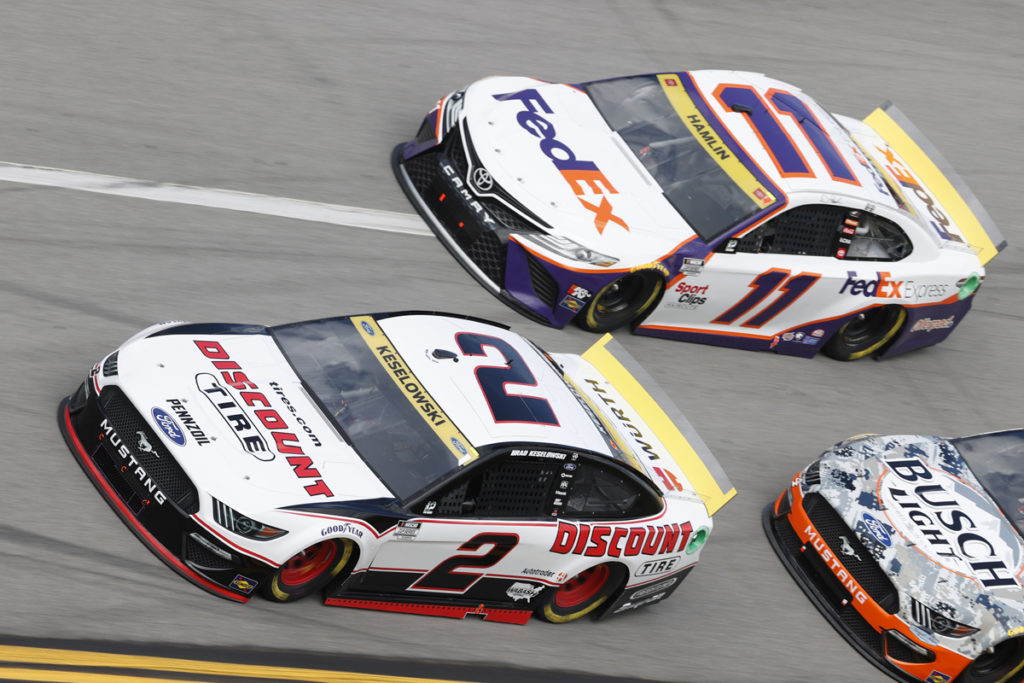
What are the other safety features in a NASCAR car?
Other safety features in a NASCAR car are Lexan glass windshields, window nets, roof flaps and an improved fuel cell among others.
Lexan windshields
NASCAR car windshields are made from an extremely strong polycarbonate compound. The polycarbonate is flexible and that is where it gets its strength from. When a hard object hits the windshield at high speed, the flexibility of the glass allows it to absorb most of the energy of the impact. The glass may get scratched but will not crack or break into pieces. Small objects that are thrown up in the air by preceding cars, leave scratch marks on car windshields, rendering them quite scratched by the end of a race. Many teams install a thin laminate over the glass to protect the costly Lexan windshield. The laminate is replaced before the next race saving costs for the team.
Window nets
The windows of a NASCAR car are covered by a mesh made from strong nylon webbing. When a car crashes, the g-forces generated due to the impact may be between fifty to a hundred times the gravitational forces. With these kinds of forces, the driver cannot prevent his hands from flailing around. This could cause serious injury to the driver’s arms and hands. The window nets prevent the driver’s hands from getting injured and makes sure that his hands from going out of the window if the glass breaks. The window nets have a quick release system to ease the driver’s exit from the car.
Roof flaps
If a car crashes at high speed, and it rotates at 140 degrees at that speed, it is very likely to be airborne. That is because the rear or the side of a car is not designed to direct the wind in the right direction to generate downforce. This generates a high pressure below the car and low pressure above, creating a negative lift. The negative lift acts as it does on a plane rendering the car airborne. NASCAR researchers decided to include roof flaps to negate this negative lift and keep the car on the ground, thus keeping the driver and possibly the car safe.
The first roof flap is aligned at an angle of 240 degrees from the car’s longitudinal centre line. When low pressure is created over the roof, the flap is sucked open. The flap opens to an angle that directs the air through a tube and disrupts the airflow over the car. This action kills the negative lift. The tube carrying the air redirected by the first flap forces open the second flap. The second flap, which is aligned at 180 degrees, further cuts the negative lift forcing the car to remain on the ground and from rolling.
By the time the car has taken a full turn both the flaps have negated the negative lift as well as slowed the car down. The car then settles and skids along the ground allowing the driver to hopefully regain control of the car.
NASCAR fuel cells
Till the 1950s, NASCAR cars used fuel tanks from whatever car they bought. Many drivers sourced larger tanks from other car manufacturers. Leaks and spillage were the cause of many fires in crashes and so were explosions. As driver safety became NASCAR’s priority, the organisation started forming rules regulating fuel tanks, also called fuel cells, of racing cars. Today the NASCAR rule book dedicates four to five pages to the construction and fixing of fuel tanks. These measures have drastically reduced fires in NASCAR accidents and kept drivers a lot safer. NASCAR also specifies the location of the fuel cell in the car.
NASCAR fuel cells are made of a steel outer layer with a hard but flexible plastic layer on the inside. The fuel cell is located towards the rear of the car and away from the driver’s seat. But the input flange of the cell is toward the front to prevent it from rupturing and spilling fuel in case of impact from behind. The cell is fixed by four strong braces directly to the roll cage to prevent it from flying loose during a crash.
The cell is filled with foam that prevents the fuel from sloshing about. If there is an explosion, the foam will absorb much of the shock and energy keeping the fuel cell intact. The foam also ensures that the fuel does not ignite and cause an explosion by limiting the supply of air inside the cell. The car has check valves that will automatically shut off the fuel supply if the engine separates from fuel supply pipes or the chassis. NASCAR fuel cells have to meet a “crashworthy” standard before being fitted in a NASCAR car. The standard is the same as the one that applies to a helicopter crashing at full speed.
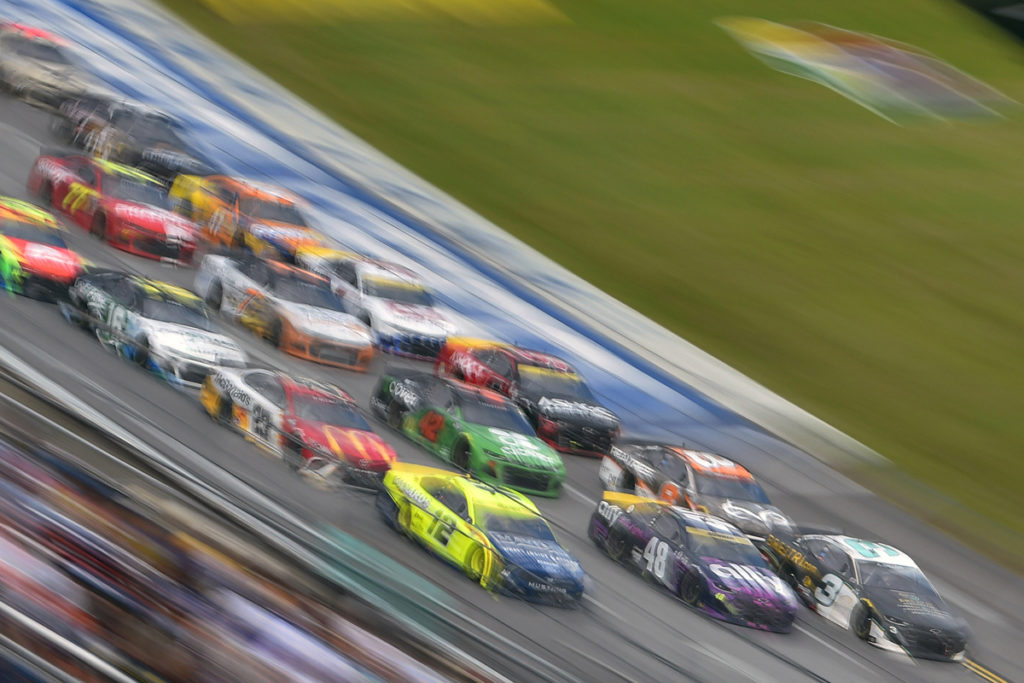
Restrictor plates
NASCAR regulates the speed of racing cars by mandating the use of restrictor plates on superspeedways like Daytona and Talladega. This was a result of several accidents, pile-ups and casualties over the year at these high-speed courses. On these super fast courses, cars exceed 200 miles per hour (321.8 kilometres per hour) by far if they are not restricted. With cars racing hardly centimetres apart, the reaction time for the drivers is very limited. A slight error in judgement on the part of one driver can cause a cascading effect and lead to devastating pile-ups.
Restrictor plates are square plates with four holes drilled in them. They are fixed at the engine air intake of the car. These plates limit the air supply to the combustion chamber of the engine which in turn reduces the rate of flow of fuel into it. This suffocates the engine reducing the speed of the car. But drivers get by this handicap by drafting. Two cars drafting in tandem can gain a speed of 5-8 miles per hour. Drivers complain that restrictor plates are the cause of many crashes. The reduction of speed because of restrictor plates cause many cars to bunch together causing more pile-ups, they say.
Banking on tracks
NASCAR cars race on ovals, tri-ovals, quad-ovals and road courses. The banking on these tracks can vary from 39 degrees to no banking at all. Banking is the maximum on ovals and next to zero or even negative banking on road courses. Cars attain maximum speeds on tracks that have substantial banking. This opportunity to race at high speeds on turns also leads to many accidents and pile-ups. The only way to reign in a car that has run out of control was concrete walls in earlier years. Most drivers that died on a race track have died from crashing into concrete walls.
NASCAR has introduced Steel and Foam Energy Reduction Barriers (SAFER Barriers) of late. These barriers are made of light-duty steel tubes backed by closed-celled polystyrene foam and are fixed against concrete walls. This barrier absorbs most of the kinetic energy of the car when a car crashes against the barrier and distributes it over a length of the wall. It thus reduces the impact energy of the car and the driver and does not propel the car back onto the track. The SAFER barriers are not as widely installed as would be desired.
Conclusion
All racing sports are dangerous to the lives of the drivers and most race drivers accept that for a fact. But most of the racing bodies are paying more and more attention to the safety of drivers and spectators over the past two decades and a half. Although any measures taken to ensure the safety of drivers will never be enough, racing bodies have to try their level best to limit fatalities and injuries to all who are concerned with the sport.
NASCAR has taken some concrete steps towards driver safety over the past two decades. The figures of crashes, incidents and deaths of drivers bear witness to that. The very fact that NASCAR is in direct coordination with safety gear manufacturers shows that NASCAR is serious about driver safety. Although most of NASCAR’s safety implementations have been reactionary to a cause, of late NASCAR has been very proactive concerning driver and car safety.
You may also be interested in: What is a stock car? 4 Interesting Facts About NASCAR cars
For more racing action, visit F1 Chronicle.
